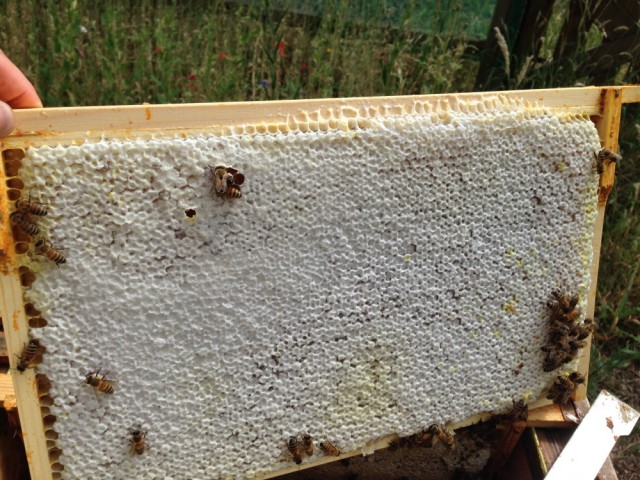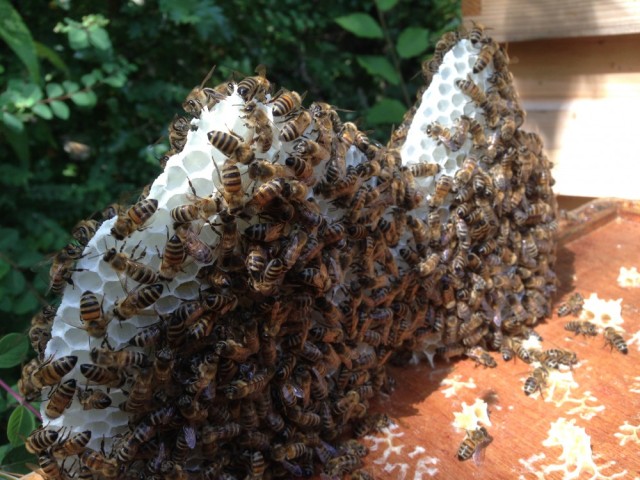This weekend I have been thinking about how lucky I am to have access to the inner world of honey bees. I must have seen inside hundreds of different hives by now, but I never get bored of watching the bees. There is always some small detail that fascinates me, like one worker sticking out her proboscis to feed another, or a bee with glowing red propolis beads clinging to her legs, or a multi-coloured frame of pollen hexagons that reminds me of a stained glass window.
At this time of year the honey vaults are particularly impressive. Lacking a queen in their brood box for a month has led to Andromeda’s ladies packing the brood frames with wall-to-wall honey. See how perfectly smooth and white the wax cappings are! And now imagine how impossibly heavy I find their brood box to lift. A frame like this weighs something like 5 pounds (2.2kg) and there are eleven frames in the brood box. They won’t all be that packed with honey but still I can imagine the brood box could easily weigh about 40 pounds (18kg) upwards now.
With some complicated juggling around of frames and spare boxes I did manage to inspect both Andromeda’s brood boxes and came to the depressing conclusion that either they’ve killed her or she’s just not laying. After finding her in the super and then moving her down into the brood box last weekend I had such high hopes of coming along yesterday and finding some lovely new frames of eggs and larvae. Instead there are three new supersedure cells. I have left them to it, I doubt they have plans to swarm this late in the season. Just hope they can produce a mated queen from one as some colonies are already beginning to kick their drones out.
Above is Emma inspecting a similarly delightful but smaller frame of honey in Melissa’s super.
Due to the various distractions of life and general absent mindedness, we had accidentally left a space in Melissa’s super as well as Pepper’s. In this case they built perfectly white undulating mounds down from the crown-board, so I was able to lift this beautiful comb out and insert a frame in the space. Bees are often incredibly reluctant to leave natural comb they’re working on, so it took a lot of smoking to persuade them to move away so I could ease the comb off. It was very flexible and soft from the heat of the hive.
Above you can see the bees busy on the tops of the super frames. At this time of year inspecting is a difficult business as there are just so many damn bees. Around 50-60,000 of them. Everywhere you try to put your hands on a frame, a bee pops up. I have been finding that inspecting without gloves amongst this mass of bees concentrates the mind wonderfully. I am actually getting stung less – because I move my fingers very slowly and carefully to secure a hold amongst the bees. Before I would get stung by accidentally squashing them, but this hasn’t happened now for weeks. The catch is very sticky, mucky hands which are harder to eat cake with afterwards!
The main summer nectar flow is probably over now that blackberry is finishing flowering, but we will still have a little from ragwort, rosebay willow herb, himalayan balsam and then ivy will be the last main nectar crop in autumn. Our focus will now turn to harvesting the honey and luckily Emma has a lovely new extractor to help with that. She has already begun spinning some of the honey out, as you can read in her post Summer surprise. The beekeeping adventures continue!







Yum. Looks delicious!
LikeLiked by 2 people
Emma says it tastes of “blackberries and lime”.
LikeLike
Oh? What a truly interesting combination! I typically call my honey “dandelion honey” because it tends to stand up and slap you around. It’s pretty potent, but tasty.
LikeLike
Beautiful photography and lovely blog 🙂 incould sit and watch them all day busy working around the hive. It’s such an amazing experience when you’re up close to them. Truly fascinating little buzzies 🙂
LikeLike
I know what you mean, wish I had them in my back garden so I could just sit and watch the entrances for ages.
LikeLiked by 1 person
Truly is an amazing world within a world!
LikeLike
Thanks Cindy, yes just so much work and play going on inside!
LikeLike
If you eat the cake first you’ll already have mucky hands for handling the frames . . . in fact, mucky cake-hands might make it easier to get a good grip on the frames.
LikeLike
Now that’s an idea 🙂
LikeLike
So the glowing red drop on their legs is propolis! It did not look like pollen but I was not sure what it really was when I’ve seen them coming back to the hive with it. Amelia
LikeLike
You were lucky to see it! Not many bees are on propolis collecting duty. Bees which collect it cannot remove it themselves but must wait for another worker to nibble it off their legs in their hive. So I have read anyway, I have yet to see this happening for myself.
LikeLike
That is fascinating but makes sense as propolis is so sticky.
LikeLike
Those frames look perfect Emily! Will one of them end up as an exhibit on the show bench? Bill
LikeLiked by 1 person
Thanks Bill, I have clever bees. I don’t drive so getting the frame to a show would be a bit of a pain. I’m happy to leave it for the bees!
LikeLike
Sorry about Andromeda. I hope there’s time to get her hive in shape for winter.
LikeLike
Thanks, me too! I am at my wit’s end with the colony by now.
LikeLiked by 1 person
Hi
Great looking frames, shame about your queen.
You mentioned that the nectar flow is almost over. When are you planning to extract the honey? I’m very pleased to have a couple of full supers after only keeping bees for 4 months. Now I’d like to get my booking in to hire one of my association extractors but have absolutely no idea when. I’m in south London which is not too far from you so I’d be interested to know your plans.
Thanks 🙂
LikeLike
Thanks Mike. Planning to extract this coming weekend and then start Apiguard treatment. If you need to book the extractor you’ll probably find you don’t have much choice of dates, at this time of year everyone else will be rushing to book it too! Get in there soon!
LikeLike
I am interested that you say that the main nectar flow is over. Round here there are a lot of plants just coming in to flower and I have full-flowering borage in the garden that is very popular with honey bees. Does that mean these dont supply much nectar?
LikeLike
Borage is great – but we just don’t have that much of it. If we had fields of borage around Londoners would be very happy beekeepers indeed. There are flowers in gardens, lavender for instance, but gardens here tend to be small and increasingly are concreted/paved/boarded over. Trees and wildflowers in places like parks or along rail tracks are often our best bet, which is why brambles are so important. Lime is often a major source of honey in London but I hear the trees haven’t produced much nectar this year.
LikeLike
Thanks Emily, that explains the situation.
LikeLike
Sorry about Andromeda. Maybe the hive just wasn’t big enough for her? I admire your glove-less state. Not quite brave enough to manage that….
LikeLike
Has Andromeda left for bigger and better things? I hope so. Perhaps she is exploring the skies right now, looking for her namesake galaxy!
LikeLiked by 1 person
Brave to work with no gloves. My personal experience of nature has been that even in the dullest of spots nature can still bring novelty and amazement for the observant.
LikeLike
What a wonderful example of a workers co-operative, but sorry about Andromeda’s demise. What would happen if the hive became full to bursting with honeycomb, would they keep producing or stop and begin to eat it themselves as there are no new offspring to feed? You have made amazing progress as a bee-keeper! I remember when I began reading your blog a few years ago you were longing for your first harvest – now it looks as though you have enough to fill a small lake! Well done.
LikeLike
The colony is always eating honey to fuel their activities, so that frees a small amount of space each day. They don’t seem to gorge themselves out of greed like some animals do! They just eat what they need. Sometimes I feel like I’ve actually become a worse beekeeper because now I’m more aware of my shortcomings, so thanks for your encouragement!
LikeLiked by 1 person